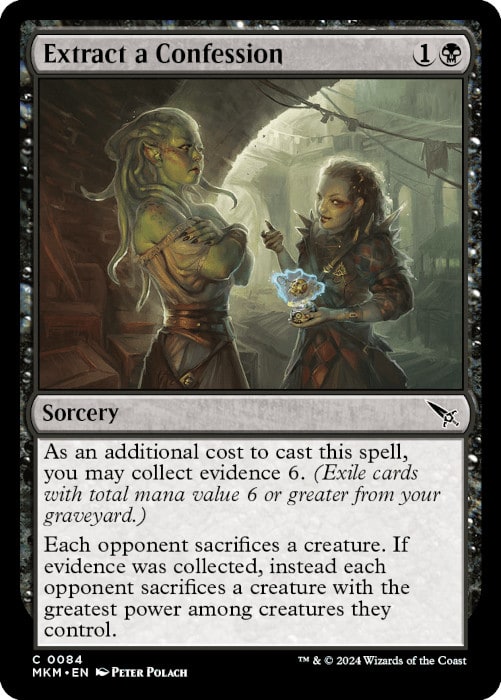Earlier this month, Mark Rosewater released an episode of his "Drive to Work" podcast discussing the mechanics used in sets this year. In it, he talked a lot about the design behind Murders at Karlov Manor, a set whose flavor, cards, and limited environment did not excite me too much at the time. Looking back though, there was a mechanic that I think was very interesting, which was collecting evidence.
Collect Evidence is a kicker-like mechanic that adds an additional cost to several spells and activated abilities in Murders at Karlov Manor. Each spell and ability with the mechanic has a certain collect evidence number attached to it that asks you to exile any number of cards from your graveyard with total mana value equal to or greater than the specified number. For example, if a card asks you to collect evidence 6, you can exile a 3-mana value and two 2-mana value cards from your graveyard to satisfy the requirement.
On most cards with these keywords, collecting evidence is an optional cost that upgrades the card in some way, with a good example being Extract a Confession. If you cast it without collecting evidence, this card is a simple-yet-effective edict, making each opponent sacrifice a creature. If you collect evidence 6 as you cast the spell, however, you make each opponent sacrifice the creature with the greatest power among creatures they control, making the spell much more effective at removing the scariest threats.
In my opinion, this mechanic is high on my list of the best mechanics of the year. I love graveyard-based mechanics like Delirium and Dredge, and this feels like a much more fair version of the incredibly broken Delve mechanic. It is also very flexible and surprisingly easy to achieve, as nearly every deck will end up with a few cards in their graveyard just by playing Magic.
The mechanic does have two flaws, however, although both of them can also apply to a lot of other mechanics we've seen in the past two years or so. First, the mechanic feels pretty under-explored at the moment, appearing mostly on commons and uncommons that aren't likely to see much play outside of draft. Second, as Maro admitted in the podcast, the flavor of the mechanic will probably limit how often it will be used in the future. While other 2024 mechanics like crimes, disguise, and valiant can be used in a lot of different settings, using detective theming for the mechanic means it can only show up on a small number of planes. It was flavorful for the detective set, but so far detectives have only shown up on Ravnica, New Capenna, and Innistrad. Granted, supplemental sets like Modern Horizons and Universes Beyond open up more possibilities, so I'm hoping we'll get to collect evidence again sooner rather than later.
Now that we've discussed Collect Evidence as a mechanic, let's talk about a few notable cards that I think exemplify how cool it can be when used correctly. First up is Incinerator of the Guilty, a six mana 6/6 dragon with flying and trample that can collect evidence X when it deals combat damage to deal that much damage to each creature and planeswalker that player controls. According to EDHREC, this is the most popular collect evidence card in the set, which makes sense because it's doing a pretty good impression of the dragon deck staple Balefire Dragon. I love the use of collect evidence X, as it makes the card incredibly versatile and potentially even better than Balefire Dragon if you have more cards in your graveyard. However, I think being a dragon is definitely boosting its popularity, as it's one of the most popular creature types in the game.
Another card I like for the same reason is Urgent Necropsy, another collect evidence card that can destroy a creature, artifact, enchantment, and planeswalker if you collect evidence X, where X is the total mana value of all target permanents. This card is very versatile, costing less than Casualties of War and being an instant, even if it can't destroy lands. Collecting enough evidence to destroy big things can be difficult, but if you're playing a self-mill deck or other similar graveyard strategy you should have plenty of junk in there to exile.
Finally, if you're playing Standard, you might be familiar with Deadly Cover-Up, a five mana wrath that destroys all creatures. However, if you collect evidence 6, you can exile a card from your opponent's graveyard to exile all copies of that card from their library, hand, and graveyard. A five-mana wrath in Black is already not a bad rate, especially for Standard and Pioneer, but the added bonus of exiling combo pieces or cards your deck struggles against makes this card a flexible roleplayer in many midrange and control strategies.
That's all for now, now get out there and catch the killer!



























